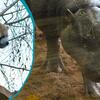As we celebrate a world first Scimitar-Horned Oryx Day, John Newby (Sahara Conservation) writes about working in the depths of the Sahara, and how one species shifted the course of his life:
For many, many people, animals in their myriad forms and functions occupy a central place in their lives. From companions that share our homes and hearts to the wild creatures inhabiting distant places, animals enrich our existence in countless ways. Their importance transcends mere utility; they touch our health, hearts, culture, economy, and spirit. In my case, one animal in particular, the scimitar-horned oryx, has played a dominant role in my life and career, and apart from a few diversions and infidelities along the way, has given me the inspiration and direction on which my life has evolved for more than fifty years.
In 1971, as a freshly graduated zoologist, I travelled to Africa as a volunteer “wildlife biologist”. My destination was the central African nation of Chad, a large and, to me at least, totally unknown country straddling the Sahara Desert and bordering Sahel grasslands. I had zero experience of Africa and even less of being a wildlife biologist. My boss, a surly Frenchman left over from the colonial period with a passion for lions and elephants, gave me a wooden trunk of pots and pans and a few tins of sardines and packed me off to a forest reserve in southern Chad with instructions to do whatever I could to help the local staff. I had the distinct impression he didn’t really expect me to achieve very much, but then again, why should he?
After six months of acquiring the basics of the trade and not succumbing too badly to the ravages of disease and my abject naivety towards the wild creatures that lived in the park, the boss suddenly turned up one and day and announced we were heading north. At that time and for several months of the year, the far south was largely impenetrable due to the abundant monsoon rains and lack of all-weather infrastructure. My new assignment was to the Ouadi Rimé-Ouadi Achim Game Reserve, an enormous Ireland-sized desert reserve comprised largely of sparsely wooded grasslands, inhabited by desert-adapted gazelles and antelopes. Enter the scimitar-horned oryx; a magnificent, long-horned, cream and tan coloured antelope. My first albeit brief encounter with this iconic species was on camelback during my very first sortie into the reserve. As a result of intense hunting pressure, both from local pastoralists and more destructive motorised hunting parties, animals like the oryx were incredibly shy, scarpering at the slightest hint of threat.
Towards the end of the year, back came the boss to take me south for another stint in the savanna. During the intervening months, travelling by camel, horse, foot and occasionally Land-Rover, I had fallen in love with the desert and its amazing fauna and flora. I guess the wide open, sparsely populated spaces appealed to my Lincolnshire upbringing, let alone the incomparable, gobsmacking vastness of the night sky. Since my arrival, I had come across oryx on many occasions and they became an obvious target for further action given their endangered status. Happily, my boss agreed, and the rest is, as they say, history.
Apart from their many attractions, the oryx is very much a keystone species and an ideal catalyst and entry point into the area’s ecology. It also stimulated my curiosity and interest in the area’s people, mostly nomadic or semi-nomadic pastoralists, with their herds of camels, cattle, sheep and goats. For them, the oryx was iconic, too, an indicator of environmental health and a valuable source of meat and hides. The people were as much a part of the environment and its ecology as the wildlife and deserved both respect and consideration when looking for viable conservation solutions.
From its humble beginnings, my passion and near-totemic relationship with the oryx and its survival have grown and led me along a fascinating and truly unique adventure. From witnessing the species’ extinction in the wild in the 1980s, establishing the Sahara Conservation Fund in the early 2000s to bring it back, and being part of its return to its former habitats in Chad in 2016, the oryx is a veritable lodestar for me. Today, the overwhelming challenge for the scimitar-horned oryx and many other threatened desert species is access to adequate habitat for the growth of viable populations and the space into which they can disperse and prosper securely. Addressing this challenge is at the heart of Sahara Conservation’s mission.
The human story is inextricably linked with the story of animals, just as mine is to the oryx. Animals are our allies, teachers, and companions—vital threads in the web of life. To cherish and protect animals is to cherish the future of our planet and our own well-being. By recognizing their importance and taking responsibility for their care, we affirm our place in the natural world—one of harmony, respect, and awe. In doing so, we ensure that the beauty, diversity, and wonder of animal life will continue to inspire and sustain us forever.
- John Newby, Senior Advisor at Sahara Conservation
All blogs reflect the views of their author and are not necessarily a reflection of BIAZA's position
-
News
 Belfast Zoo helps to bring Christmas joy to Children’s Hospital 19th December, 2025Belfast Zoo joined the Lord Mayor of Belfast, Councillor Tracy Kelly, on Monday (15th December) to help bring festive cheer to the Royal Belfast Hospital…
Belfast Zoo helps to bring Christmas joy to Children’s Hospital 19th December, 2025Belfast Zoo joined the Lord Mayor of Belfast, Councillor Tracy Kelly, on Monday (15th December) to help bring festive cheer to the Royal Belfast Hospital… -
News
 Colchester Zoological Society welcomes new arrivals 19th December, 2025This December, Colchester Zoological Society (CZS) welcomed some exciting new arrivals! A young male pygmy hippo, Mikolas, from Zoo Dvur Kralove…
Colchester Zoological Society welcomes new arrivals 19th December, 2025This December, Colchester Zoological Society (CZS) welcomed some exciting new arrivals! A young male pygmy hippo, Mikolas, from Zoo Dvur Kralove… -
News
.png?w=100&h=100&zc=1&f=jpeg&hash=8d175f93cde920c5ba23c8ea7f92e55a) Blog: Understanding the human side of zoos 16th December, 2025Why are zoo researchers increasingly looking to social science? Dr Nieky van Veggel explains the significance of understanding the human dimension…
Blog: Understanding the human side of zoos 16th December, 2025Why are zoo researchers increasingly looking to social science? Dr Nieky van Veggel explains the significance of understanding the human dimension…

.png?w=100&h=50&zc=1&f=jpeg&hash=d39fdd37c06aa1468a1d926d84189e8c)

